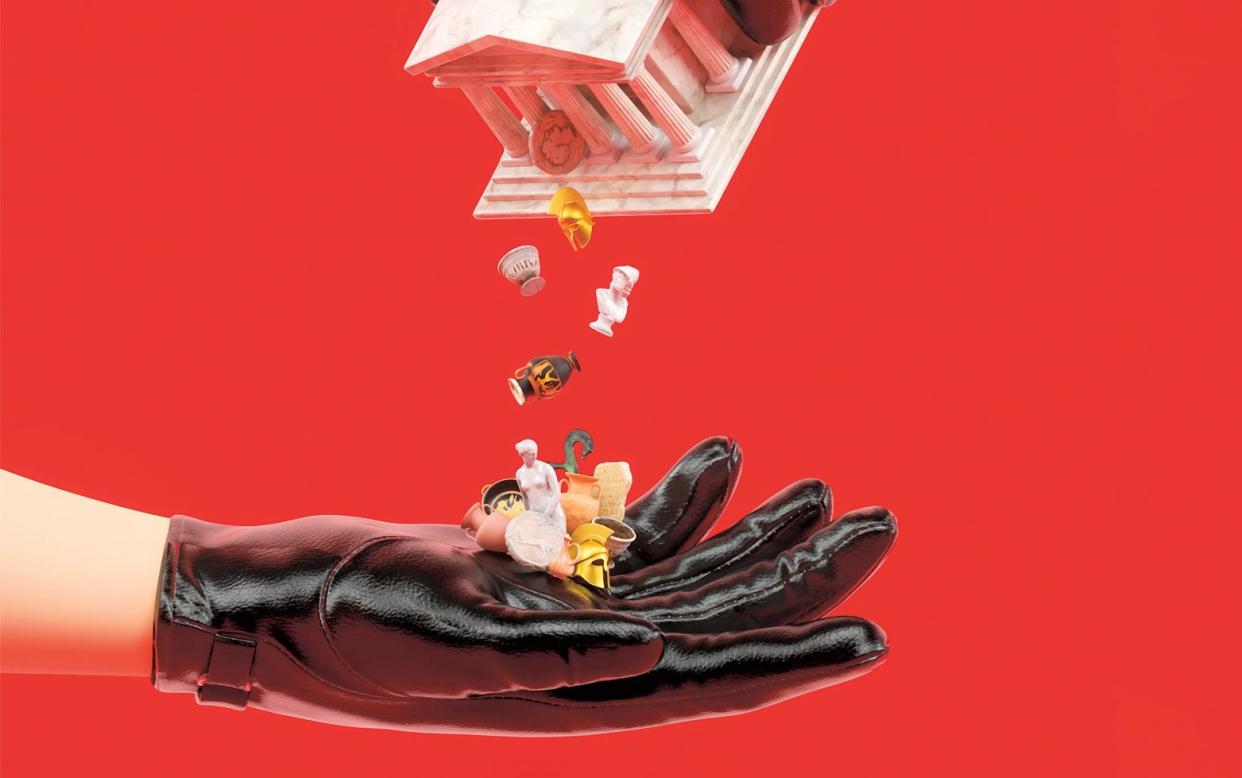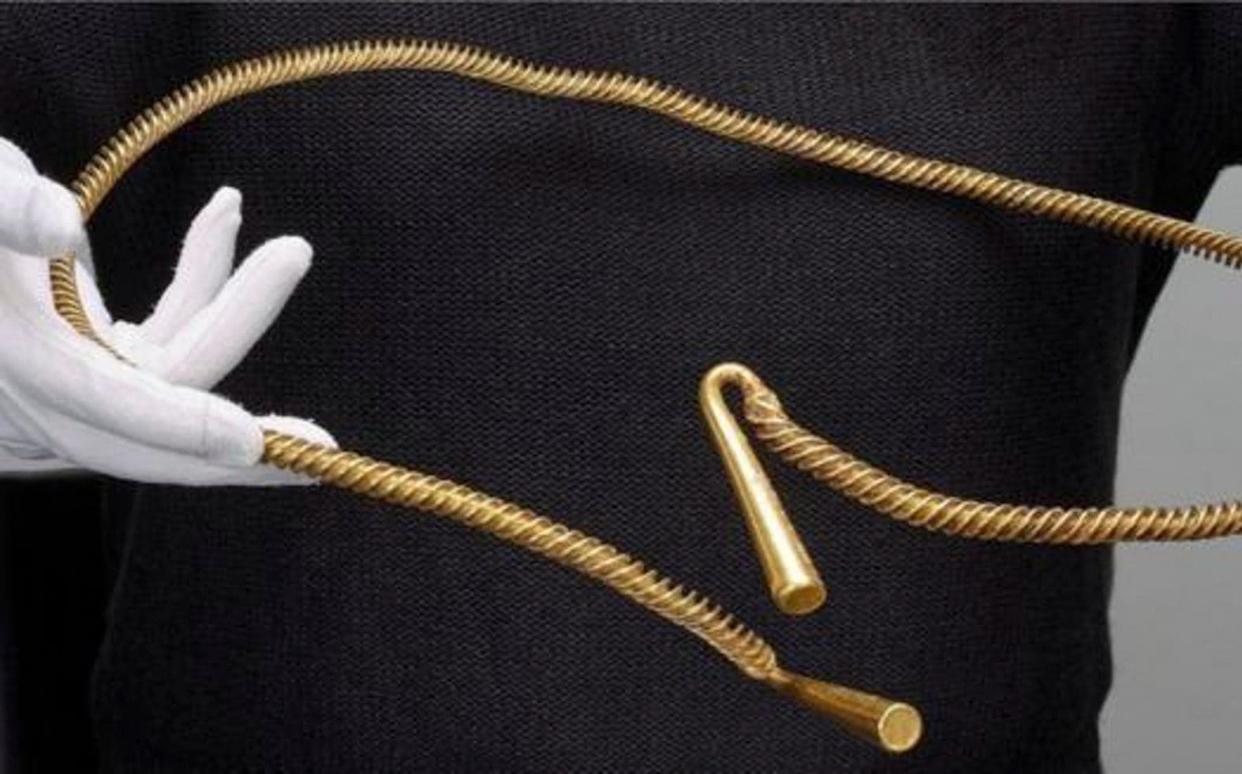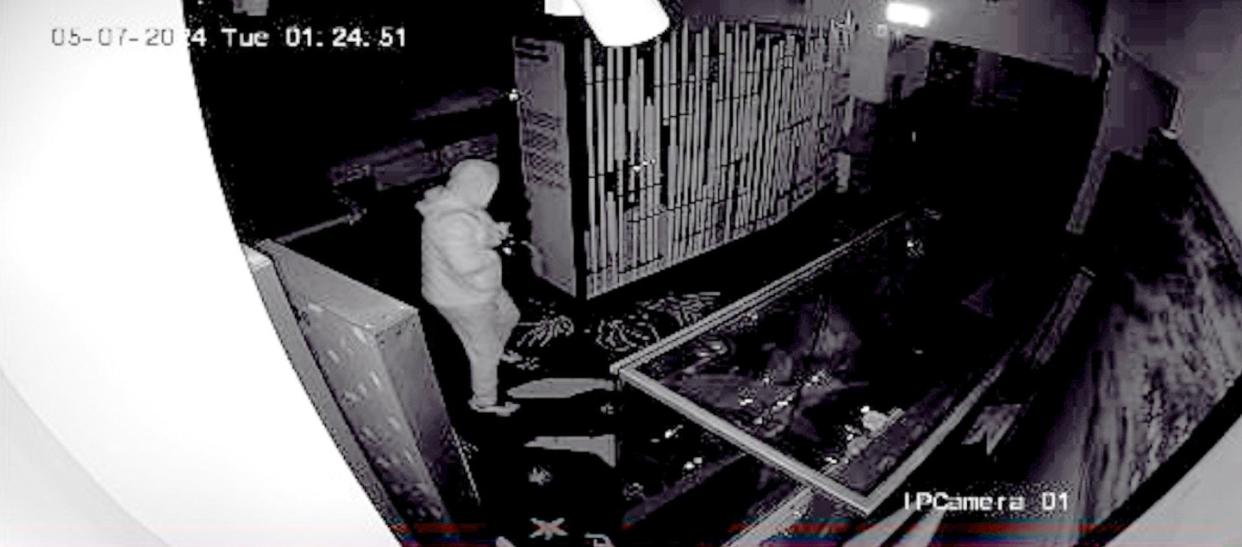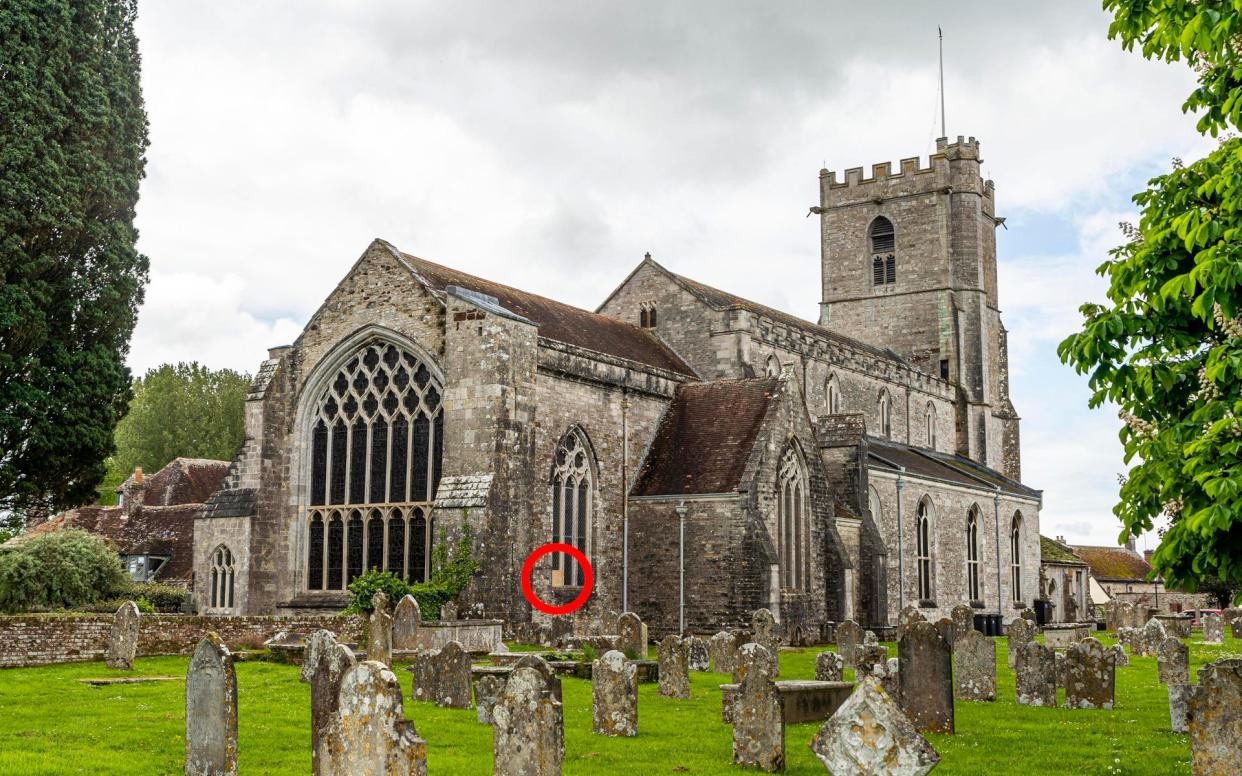The million-pound theft trend sweeping through Britain’s museums and churches

At 1.24am on the first Tuesday in May, Elie Hughes, the curator of Ely Museum, was roused by an automated alarm-response call to her mobile. Her home is close to the museum, but when she pulled up in the little staff car park moments later – and just before the police arrived – it was already too late.
‘A shuttered window had been forced open,’ she says. ‘I just hoped it was an opportunist break-in, and that when the alarm went off it had frightened them away.’ But that wasn’t the case.
The CCTV clip released by Cambridgeshire police in the days following shows precisely what happened. A camera in the gift shop captures two black-clad figures clambering in through a jemmied window. Both wear hooded anoraks; one holds a sledgehammer. Far from opportunists, these are men on a focused mission, as they hurry into an adjoining exhibition room, where an infrared camera shows them disappearing round the back of a storytelling enclosure, built during the museum’s recent redesign.
When they exit the scene at speed, one carries something long and thin, dangling: a Bronze Age gold torc (an ornamental ring worn around the neck), one of the most beautifully crafted and heaviest ever found in this country.

It was uncovered in a nearby ploughed field by a metal detectorist in 2015, having lain there for 3,000 years, and was acquired by the museum amid great fanfare two years later, following a £220,000 fundraising drive to which hundreds of locals contributed. So finely wrought is this artefact, an X-shaped gold bar twisted into a perfect spiral, that when Hughes commissioned a skilled craftsman to make a copy for the museum’s education programme, even with modern precision tools he found it almost impossible.
The thieves also took the collection’s other star exhibit – a Bronze Age bracelet made of pure gold. The entire robbery had taken them just 46 seconds.
‘We’re all still really struggling,’ says Hughes. ‘We’re sad and we’re angry. I’ve had people saying it feels like they’ve been punched, the shock and that overwhelming feeling of loss. Especially people who donated towards it, they’re saying this feels really personal. I wanted that to stay in my local community and I put my hand in my pocket to make sure that it did. And now somebody has taken it away.’

For museum staff, the only hope is that the pieces were stolen to order for an unscrupulous collector and may yet be recovered intact. But far more likely is the possibility that they will have already been melted down – the torc alone weighs in at 730g, worth about £43,000 at the current price for gold on the global markets – and if that’s the case, their stories and extraordinary craftsmanship will be lost for ever.
In March Historic England and the National Police Chiefs’ Council released a new report on heritage crime, revealing a rise in thefts of cultural objects from art galleries and museums. Using data gathered between early 2020 and early 2023, it found that there had been a nine per cent year-on-year increase in stone theft from England’s historic sites.
The estimated value of cultural property stolen in 2021/22 is estimated to be £3.2 million – but this figure is likely a low-ball outlier, particularly when one takes into account certain ‘super heists’.
In 2012 18 jade artefacts, worth £15 million, were stolen from the Fitzwilliam Museum in Cambridge, and in 2018 a diamond tiara valued at £3.5 million was taken from a gallery on the Welbeck Estate in Worksop. The following year, an 18ct-gold lavatory valued at £4.8 million, which was part of an installation by the Italian conceptual artist Maurizio Cattelan, was stolen from an exhibition at Blenheim Palace. A reward of £100,000 was offered by insurers. But it would be years before four men were charged with the crime, three of whom have pleaded not guilty. Their trial is due to start next year. And, as is so often the case in heritage theft, big ticket or otherwise, not one of these stolen objects has been recovered.

Organised heritage crime is a cops-and-robbers technological arms race. High-definition CCTV and smart alarms are now affordable to most businesses, and forensic techniques such as SmartWater (a liquid containing a unique code) have revolutionised security marking. On the flipside, the new generation of cordless power tools makes quick work of every physical barrier, from reinforced concrete to bulletproof glass, so that even if a gang is caught on multiple cameras and every alarm is tripped, by the time the police arrive they’ve got what they came for and vanished.
‘I was always told as a junior cop that if a criminal really wants to complete a crime, they’ll complete the crime,’ says Mark Harrison, a former chief inspector who is now head of heritage crime strategy at Historic England, and an esteemed community archaeologist.
The kit at their disposal means this holds true for even the most ambitious heritage thieves. ‘The minute anything goes on display it becomes incredibly vulnerable,’ confirms Dr Matt Pope, an associate professor at UCL’s Institute of Archaeology. ‘There is money to be made, and everyone knows it.’
The internet is a sprawling battleground in this conflict. Criminals can trawl online resources to identify where valuable items are kept, just as they can use Google Maps satellite overlays and websites to identify vulnerable targets, and plot entrances and escape routes.
‘During lockdown, historic premises really opened themselves up online,’ says Assistant Chief Constable Rachel Nolan of Essex police, and the National Police Chiefs’ Council’s lead on heritage crime. ‘It’s a sad fact that this gave a really easy opportunity for criminals to check out security: window locks, CCTV, access points.’
But the internet’s all-seeing eye also makes it difficult, often impossible, for thieves to sell a rare haul for anything near its true worth. When any high-value antiquity is stolen, it’s all over the internet. This, sadly, is why it probably won’t be seen again – safer to melt it down or break it up and sell off parts. For example, the £3.5 million tiara, made by Cartier for the Duchess of Portland to wear at Edward VII’s coronation, is believed to have been smuggled to Turkey and broken up for its gold and diamonds.

The ever-rising value of precious stones and metals is an obvious factor behind this crime wave, but there’s a more immediate issue: burgeoning public interest in our heritage, and a desire to engage with it up close. These days visitors expect historic properties to show off their great artworks and original pieces in open displays, rather than behind security glass. Add to this the fact that there is chronic understaffing, and you have a recipe for widespread opportunist theft.
‘Things have gone missing from every place I’ve worked, on a very regular basis,’ says an experienced heritage employee, who has worked at a large stately home for the past year, and previously at several museums across England. ‘Small paintings or prints, jewellery, coins, vintage newspapers, anything a visitor can conceal about their person.
‘They generally aren’t serious criminals looking to make money. It’s more just, “Oh, nobody’s looking, I’ll have that as a nice souvenir.”’
In one recent incident, he visited a room during closing time, and noticed a modest 18th-century silver ring was missing from a collection on a table near the roped-off visitor viewing area. After an extensive search, his team reported it to the police, who are currently investigating it as theft.
Dispiriting as these casual robberies are, they are an inevitable price to be paid for more open public access. Such crimes are rarely reported – and so the stolen items are hardly ever recovered.
‘In many ways it’s just a matter of scale,’ says Mark Harrison. ‘The sheer number of historic sites in this country means you’re always going to struggle to secure and police them.’
The National Heritage List, spanning scheduled monuments, listed buildings, battlefields and protected shipwrecks, now holds more than 400,000 entries. The Church of England alone has nearly 16,000 buildings, and there are 1,800 accredited museums in the UK, a few so enormous that the issue of scale becomes an in-house crime-prevention dilemma in itself.
Last year a senior curator at the British Museum was sacked for gross misconduct and accused of taking items that dated back to 1,500BC.
Dr Peter Higgs, the museum’s curator of Mediterranean cultures, had worked there for more than 30 years, until it emerged that as many as 2,000 items were missing from the Greek and Roman department. He was accused of selling items on eBay: various accounts suggested that coins, gems and jewellery from the museum were sold typically at a tiny fraction of their true worth.
Civil proceedings against him were launched by the British Museum in March. Court documents stated that the British Museum believed Dr Higgs had pocketed an estimated £100,000 from stealing, damaging, melting down and selling the artefacts. Dr Higgs has denied any wrongdoing and no criminal charges have been brought.

The challenge is that most of the missing items had never been photographed or catalogued. With dwindling staff numbers and a collection totalling eight million objects, this task was deemed insurmountable.
Inadequate record keeping is Rachel Nolan’s biggest bugbear when it comes to policing thefts: ‘Every site and institution should know exactly what they have and make sure it’s all photographed, be it a piece of stone or an item with historic value. If it’s taken and we can’t properly describe it, that’s a serious challenge.’
Harrison stresses that every police force in the country can now call upon a specialist heritage crime officer. And yet convictions are rare. This is not only the case with the heritage items but with the theft of valuable urns, benches and sundials stolen from public property. Salvo, the UK’s largest architectural salvage marketplace, has an online ‘theft alert’ classified section, listing them all – there are pages and pages.
Old York flagstones are another target for robberies – they can sell for as much as £200 per square yard. Church paths, bridges and historic streets across the country have been laid waste by these thefts, often brazenly carried out in broad daylight, and requiring little more than a crowbar, a transit van and some high-vis jackets to deceive onlookers into thinking that they’re official workers.
Even when police work does result in a conviction, the sentences often don’t seem to reflect the crime or the sheer amount of work it takes to catch the culprits.
Take the gang who had removed £30,000 worth of York coping stone from Tatton Park in Cheshire. They were apprehended only after an off-duty policeman noticed a van driving slowly alongside the walls. A subsequent search unearthed a discarded cigarette packet that provided a DNA clue, and forensic scientists liaising with Mark Harrison were able to match soil and plant samples from stone found in the van with that of the depleted wall. In December 2022 the gang were convicted – and yet after a two-year investigation they were sentenced to just two years, suspended for 18 months.
Determined to protect their artefacts, some heritage sites are now finding their own ways of policing their properties. English Heritage is currently trialling the use of staff bodycams, similar to those worn by police, at a few of the 400 historic sites it manages.
‘We would always want staff to challenge suspicious activity,’ says Rachel Nolan, ‘but if it’s a large group of men in fluorescent jackets or that type of possibly intimidating scenario, body cameras mean you can capture important evidence without confrontation.’
Historic England, meanwhile, are mobilising the public. Heritage watch schemes, encouraging people to report crime or suspicious behaviour at local historic assets, now operate in Essex, Cheshire, Hertfordshire, Kent and York. In Essex there’s a mounted division, trained to monitor the heritage landscape on horseback. ‘Horse riders really know their local communities,’ says Nolan, ‘and obviously a lot of sites are extremely rural, off the beaten track but perhaps close to a bridle path.’
An awareness training programme aimed at scrap-metal dealers is also already paying dividends, according to Harrison. Thieves who prised six bronze plaques from a war memorial in Ilfracombe this January were arrested, and later imprisoned, after offering them to a local scrap merchant who raised the alarm. But although ID is now a legal requirement when selling certain metals such as lead to scrap dealers, bafflingly, gold and silver are excluded from this legislation.
Churches, often isolated and unlocked, are a perennial target. In the 12 months to July 2021, some 4,169 crimes – mostly theft and vandalism – were committed at UK religious premises. ‘Church metal is very rarely seen again,’ says Harrison with a sigh.
A spate of nighttime raids saw antique ecclesiastical silver valued at more than £100,000 stolen from church safes in Dorset, Suffolk and Lancashire last year. A highly professional gang is thought to have been behind them all.
Cameras were disabled, and in one case a hard drive that recorded the CCTV video was removed from a locked cupboard. Surfaces had been sprayed in lubricant to avoid fingerprints. When the gang’s drill failed to do the job at Lady St Mary’s, Wareham, in Dorset, explosives were used to blow open the vestry safe. The 26 pieces of communion plate lost in this robbery included an Elizabethan chalice engraved with the church’s name, valued at £30,000.

‘It has been in the church almost 500 years,’ said Canon Simon Everett, ‘and it has gone missing on our watch. There is anger, there is rage. Some people were in tears. You don’t expect explosives being used to open safes in darkest Dorset.’
He also notes that the thieves were discerning. ‘They only took solid silver and left the silver plate.’
Over in Kent, another robbery shook the congregation, and saw the loss of another equally loved item.
Every sermon at St John the Evangelist in Kingsdown, near Deal, had – since 1853 – been delivered from a majestic six-foot brass lectern, topped with an eagle and studded with polished gemstones. Then, in May 2022, a warden unlocking the church found the front door jemmied and a void where the lectern had stood.
‘We’d had quite a few daytime robberies in the previous year or two,’ says the current churchwarden, Elizabeth Bembridge. ‘A donation box was levered off and pinched, a votive offering box prised open… But this was very different.’
Rachel Nolan is aware of this when investigating such crimes. ‘I’m always incredibly mindful that these crimes have a reach across entire communities... It means so much to so many people when treasured items are recovered, and perpetrators brought to justice.’
In the case of the Kingsdown church, the treasure has yet to be recovered – but a thief was detained. CCTV analysis led police to a van owned by a local man, 27-year-old Robert Watson. In the back they discovered the lectern’s wooden plinth, and a hacksaw blade bearing traces of brass. Watson was later sentenced to a year in prison, having refused to identify the accomplice seen on the CCTV footage, or divulge the lectern’s fate.
‘The police tracked his van to Essex using automatic number-plate recognition,’ says Bembridge. She suspects that the lectern was driven to a scrapyard and melted down. ‘We’d had it valued at £10,000, but the police told me that as scrap metal he would have been paid around £70. Barely enough to cover his petrol.’ A campaign was started to raise funds for a replica brass lectern, but soon abandoned. ‘We all thought, what’s the point? It’ll just be pinched again.’ There is a sense of defeat.
At Ely Museum, however, the staff are standing strong. The building is now protected by a state-of-the-art alarm system and heavy-duty security shutters, but the collections are still shown rather than locked away.
‘Of course we could keep these kinds of objects for research and preservation, out of public view,’ says Elie Hughes. ‘But I work in a museum so that people can be excited, so they can learn about items from their past. Accessibility, enjoyment, education – that’s why we’re here. That’s what museums are for. And if we close the doors and put the shutters down, what’s the point?’


